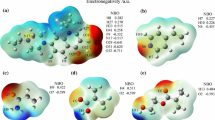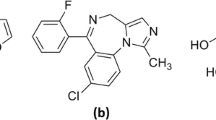Abstract
The purpose of this work was to investigate, via DFT calculations, the molecularly imprinted polymer (MIP) for atenolol (ATL) β-blocker evaluating distinct functional monomers (FMs), solvents, and cross-linker agents (CLAs). As the main result, we could determine from structural and thermodynamic data the best MIP synthesis protocol as being: p-vinyl benzoic acid (APV) as FM, toluene as solvent, and pentaerythritol triacrylate (PETRA) as CLA. We believe this rational design can be very useful for experimentalists in an attempt to perform an efficient synthesis of a MIP for this important β-blocker drug.





Similar content being viewed by others
Code availability
Not applicable.
Data availability
Not applicable.
References
Sajini T, Mathew B (2021) A brief overview of molecularly imprinted polymers: highlighting computational design, nano and photo-responsive imprinting. 4: 100072. https://doi.org/10.1016/j.talo.2021.100072
Malik MI, Shaikh H, Mustafa G, Bhanger MI (2019) Recent applications of molecularly imprinted polymers in analytical chemistry. Purif Rev 48:179–219. https://doi.org/10.1080/15422119.2018.1457541
Paulina S, Marcin K, Piotr K, Michal S (2013) Molecularly imprinted polymers’ applications: a short review. Mini-Rev Org Chem 10:400–408. https://doi.org/10.2174/1570193X11310030016
Wulff G (1995) Molecular imprinting in cross-linked materials with the aid of molecular templates—a way towards artificial antibodies. Angew Chem Int Ed 34:1812–1832. https://doi.org/10.1002/anie.199518121
Nicholls IA, Adbo K, Andersson HS, Andersson PO, Ankarloo J, Dahlstrom JH, Jolela P, Karlsson JG, Olofsson L, Rosengren J, Shoravi S, Svenson J, Wikman S (2001) Can we rationally design molecularly imprinted polymers? Anal Chim Acta 435:9–18. https://doi.org/10.1016/S0003-2670(01)00932-1
Subrahmanyan S, Piletsky SA (2009) Computational design of molecularly imprinted polymers. Springer Science, LCC. https://doi.org/10.1007/978-0-387-73713-3_6
Levi L, Raim V, Srebnik J (2011) A brief review of coarse-grained and other computational studies of molecularly imprinted polymers. J Mol Recog 24:883–891. https://doi.org/10.1002/jmr.1135
Cowen T, Karim K, Piletsky S (2016) Computational approaches in the design of synthetic receptors - A review. Anal Chim Acta 936:62–74. https://doi.org/10.1016/j.aca.2016.07.027
De Barros LA, Custódio R, Rath S (2014) Design of a new molecularly imprinted polymer selective for hydrochlorothiazide based on theoretical predictions using Gibbs free energy. J Braz Chem Soc 27:2300–2311. https://doi.org/10.5935/0103-5053.20160126
Ahmadi F, Yawari E, Nikbakht M (2014) Computational design of an enantioselective molecular imprinted polymer for the solid phase extraction of S-warfarin from plasma. J Chromat A 1338:9–16. https://doi.org/10.1016/j.chroma.2014.02.055
Torkashvand M, Gholivand MB, Taherkhani F (2015) Fabrication of an electrochemical sensor based on computationally designed molecularly imprinted polymer for the determination of mesalamine in real samples. Mater Sci Eng C Mater Biol Appl 55:209–217. https://doi.org/10.1016/j.msec.2015.05.031
Karimian N, Gholivand MB, Taherkhani F (2015) Computational design and development of a novel voltammetric sensor for minoxidil detection based on electropolymerized molecularly imprinted polymer. J Electroanal Chem 740:45–52. https://doi.org/10.1016/j.jelechem.2014.12.024
Fernandes LS, Homem-De-Mello P, Lima EC, Honório KM (2015) Rational design of molecularly imprinted polymers for recognition of cannabinoids: a structure-property relationship study. Eur Polym J 71:364–371. https://doi.org/10.1016/j.eurpolymj.2015.08.005
Tadi KK, Motghare RV, Ganesh V (2015) Electrochemical detection of epinephrine using a biomimic made up of hemin modified molecularly imprinted microspheres. RSC Adv 5:99115–99124. https://doi.org/10.1039/C5RA16636E
Nezhadali A, Senobari S, Mojarrab M (2016) 1,4-dihydroxyanthraquinone electrochemical sensor based on molecularly imprinted polymer using multi-walled carbon nanotubes and multivariate optimization method. Talanta 146:525–532. https://doi.org/10.1016/j.talanta.2015.09.016
Prasad BB, Singh R, Kumar A (2016) Development of imprinted polyneutral red/electrochemically reduced graphene oxide composite for ultra-trace sensing of 6-thioguanine. Carbon 102:86–96. https://doi.org/10.1016/j.carbon.2016.02.031
Fonseca MC, Nascimento Jr. CS, Borges KB (2016) Theoretical investigation on functional monomer and solvent selection for molecular imprinting of tramadol. Chem Phys Lett 645:174–179. https://doi.org/10.1016/j.cplett.2015.12.061
Silva CF, Borges KB, Nascimento Jr. CS (2018) Rational design of a molecularly imprinted polymer for dinotefuran: theoretical and experimental studies aimed at the development of an efficient adsorbent for microextraction by packed sorbent. Analyst 143:141–149. https://doi.org/10.1039/C7AN01324H
Pereira TFD, Silva ATM, Borges KB, Nascimento Jr. CS (2019) Carvedilol-imprinted polymer: rational design and selectivity studies. J Mol Struc 1177:101–106. https://doi.org/10.1016/j.molstruc.2018.09.043
Silva CF, Borges KB, Nascimento Jr. CS (2019) Computational study on acetamiprid-molecular imprinted polymer. J Mol Model 25:104–108. https://doi.org/10.1007/s00894-019-3990-y
Nascimento TA, Silva CF, Oliveira HL, Silva RSC, Nascimento Jr. CS, Borges KB (2020) Magnetic molecularly imprinted conducting polymer for determination of praziquantel enantiomers in milk. Analyst 145:4245–4253. https://doi.org/10.1039/D0AN00703J
Teixeira LS, Silva CF, Oliveira HL, Dinali LAF, Nascimento Jr. CS, Borges KB (2020) Microextraction by packed molecularly imprinted polymer to selectively determine caffeine in soft and energy drinks. Microchem J 158:105252. https://doi.org/10.1016/j.microc.2020.105252
Silva CF, Nascimento Jr. CS (2020) Polímero de impressão molecular para o tiacloprido: uma investigação teórica. Quím Nova 43:1439–1446. https://doi.org/10.21577/0100-4042.20170618
Silva CF, Menezes LF, Pereira AC, Nascimento Jr. CS (2021) Molecularly imprinted polymer (MIP) for thiamethoxam: a theoretical and experimental study. J Mol Struc 1231:129980. https://doi.org/10.1016/j.molstruc.2021.129980
Teixeira RA, Dinali LAF, Silva CF, Oliveira HL, Silva ATM, Nascimento Jr. CS, Borges KB (2021) Microextraction by packed molecularly imprinted polymer followed by ultra-high performance liquid chromatography for determination of fipronil and fluazuron residues in drinking water and veterinary clinic wastewater. Microchem J 168:106405. https://doi.org/10.1016/j.microc.2021.106405
Suryana S, Mutakin YR, Hasanah AN (2021) An update on molecularly imprinted polymer design through a computational approach to produce molecular recognition material with enhanced analytical performance. Molecules 26:1891. https://doi.org/10.3390/molecules26071891
Do Vale GT, Ceron CS, Gonzaga NA, Simplicio JA, Padovan JC (2019) Three generations of β-blockers: history, class differences and clinical applicability. Curr Hypertens Rev 15:22–31. https://doi.org/10.2174/1573402114666180918102735
Lee C, Yang W, Parr RG (1988) Development of the Colle-Salvetti correlation-energy formula into a functional of the electron density. Phys Rev B 37:785–789. https://doi.org/10.1103/PhysRevB.37.785
Marenich AV, Cramer CJ, Thulhar DG (2009) Universal solvation model based on solute electron density and on a continuum model of the solvent defined by the bulk dielectric constant and atomic surface tensions. J Phys Chem B 113:6378–6396. https://doi.org/10.1021/jp810292n
Boys SF, Bernardi F (1970) The calculation of small molecular interactions by the differences of separate total energies. Some procedures with reduced errors. Mol Phys 19:553–566. https://doi.org/10.1080/00268977000101561
Frisch MJ et al (2009) Gaussian 09, revision D.01. Gaussian, Inc., Wallingford
Gadre SR, Suresh CH, Mohan N (2021) Electrostatic potential topology for probing molecular structure, bonding and reactivity. Molecules 26:3289. https://doi.org/10.3390/molecules26113289
Zhang T, Liu F, Chen W, Wang J, Li K (2001) Influence of intramolecular hydrogen bond of templates on molecular recognition of molecularly imprinted polymers. Anal Chim Acta 450:53–61. https://doi.org/10.1016/S0003-2670(01)013903
Funding
The authors would like to thank the Brazilian agencies CNPq (Conselho Nacional de Desenvolvimento Científico e Tecnológico) and FAPEMIG (Fundação de Amparo à Pesquisa do Estado de Minas Gerais) for financial support. This study is also part of the project involving the Rede Mineira de Química (RQ-MG) supported by FAPEMIG.
Author information
Authors and Affiliations
Contributions
We declare that this work was done by the authors named in this article, and all liabilities pertaining to claims relating to the content of this article will be borne by the authors. In addition, a declaration of the role of each author is mentioned as follows: CSN participated in the supervision, validation, analysis of the results, writing—original draft preparation, writing—reviewing, and editing; CFS in the methodology, software, and data curation; PPM in the investigation, analysis of the results, and discussion; LCZ in the analysis of the results and discussion. All authors read and approved the final manuscript.
Corresponding author
Ethics declarations
Conflict of interest
The authors declare no competing interests.
Additional information
Publisher's note
Springer Nature remains neutral with regard to jurisdictional claims in published maps and institutional affiliations.
This paper belongs to Topical Collection: XXI - Brazilian Symposium of Theoretical Chemistry (SBQT2021).
Rights and permissions
About this article
Cite this article
Maia, P.P., Zin, L.C., Silva, C.F. et al. Atenolol-imprinted polymer: a DFT study. J Mol Model 28, 177 (2022). https://doi.org/10.1007/s00894-022-05171-2
Received:
Accepted:
Published:
DOI: https://doi.org/10.1007/s00894-022-05171-2




